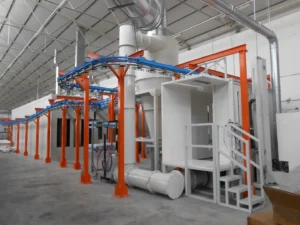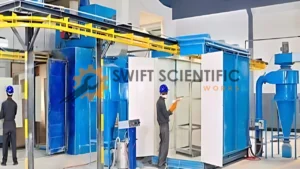Powder coating is a popular and highly effective method of applying a protective and decorative finish to a wide range of metal and non-metal surfaces. For this we provide a powder coating plant which helps to coat metals and resist corrosion. Our coating plants are known for their durability, strong build design. Powder coating is widely used in industries such as automotive, architecture, home appliances, and industrial equipment.
Swift Scientific Works specialize in innovative and precise powder coating plants. In this blog, we explain through the complete step-by-step process of how powder coating is done, from surface preparation to curing—highlighting why it’s the preferred choice over traditional liquid painting.
What is Powder Coating?
Powder coating is a dry finishing process that uses a free-flowing, electrostatically charged powder to coat surfaces. The powder is typically made from thermoplastic or thermoset polymers mixed with pigments, leveling agents, and curing agents. Once applied, the powder is heated to form a hard, uniform, and attractive finish.
Materials That Can Be Powder Coated
Powder coating is ideal for: Mild steel, stainless steel, aluminum, Automotive parts like wheels, bumpers, chassis, Furniture frames, Bicycle frames, Electrical appliances, Metal railings and fences. Recent advancements also allow powder coating on heat-resistant non-metals like MDF (medium-density fiberboard) and some plastics using specialized techniques.
How Powder Coating is Done
Let’s break down the powder coating process into key stages:
- Surface Preparation – Proper surface preparation is the most critical step in ensuring a smooth and long-lasting finish. The goal is to remove any contaminants—dust, oil, grease, rust, or old paint—from the object’s surface.
Preparation methods include:
Degreasing: To eliminate oils and surface residue.
Chemical Etching: Using acid or alkaline cleaners for enhanced adhesion.
Sandblasting or Shot Blasting: Abrasive cleaning to remove rust, paint, or scale and to roughen the surface for better powder grip.
Phosphate Coating: Often used on steel to increase corrosion resistance and adhesion.
A clean surface = better powder adhesion and longer coating life. - Masking – In some cases, parts of the object need to be protected from coating (e.g., threads, holes, or contact points). These areas are masked using high-temperature tapes or silicone plugs that can withstand the curing oven’s heat.
- Electrostatic Powder Application – Now comes the core of the process—applying the powder:
A powder coating gun is used to spray the powder onto the surface.
The gun charges the powder particles electrostatically, which makes them attracted to the grounded metal surface.
The object is evenly coated with a cloud of charged powder particles.
This stage takes place in a powder spray booth equipped with filters or recovery systems to capture overspray for reuse, reducing waste. - Curing in an Oven – Once coated, the object is transferred into a curing oven where it’s baked at temperatures between 160°C to 220°C (320°F to 430°F) for about 10–30 minutes, depending on the powder type and part thickness.
- Cooling and Inspection – After curing, the parts are allowed to cool down naturally. Once cooled:The masking is removed (if applied). The product is visually and mechanically inspected for uniformity, thickness, gloss, and imperfections.
Advantages of Powder Coating
- Durability: Resistant to chipping, scratching, fading, and corrosion.
- Eco-Friendly: No harmful solvents or VOCs (Volatile Organic Compounds).
- Cost-Effective: Less waste, overspray recovery, and no need for multiple coats.
- Variety of Finishes: Multiple textures, colors, and gloss levels.
- Quick Turnaround: Fast curing and drying times reduce production delays.
Conclusion
Powder coating is a versatile, sustainable, and high-performance coating method that continues to replace traditional painting in many industries. Its eco-friendliness, durability, and aesthetic flexibility make it a top choice for manufacturers, contractors, and designers alike.
At Swift Scientific Works, we take pride in offering precision powder coating plants using state-of-the-art equipment and premium powders. Whether it’s a single part or high-volume industrial coating plants, our process ensures long-lasting protection and professional results every time.





